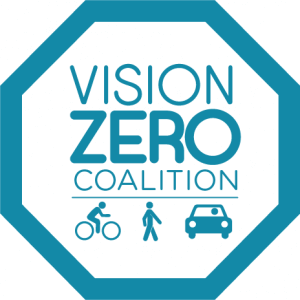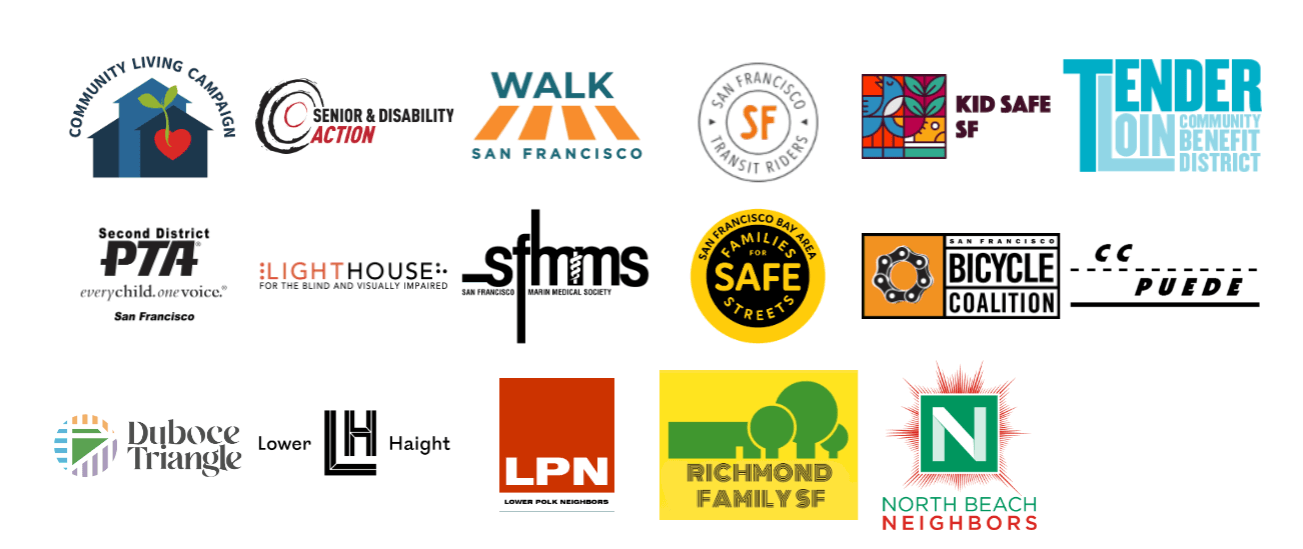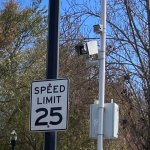Groups from across San Francisco ask leaders to refocus on Vision Zero
The Vision Zero Coalition is made up of groups from across the entire city that care about traffic safety. Yesterday, this letter was hand-delivered to Mayor London Breed, and today it was sent to every City agency leader. Please echo this message by sending a personal email to City leaders now.
March 20, 2024
Mayor London Breed
City Hall
1 Dr. Carlton B. Goodlett Place, Room 200
San Francisco, CA 94102
CC: SFCTA Board Members; SFCTA Director, Tilly Chang; SFMTA Director, Jeffrey Tumlin; SFMTA Board Members; SFDPH Director, Grant Colfax; SFDPW Director, Carla Short; SFPD Chief, William Scott; SFFD Chief, Jeanine Nicholson; SFUSD Superintendent, Matt Wayne; SF Police Commissioners; SF Fire Commissioners; SF Heath Commissioners; SF Public Works Commissioners; SF School Board

Dear Mayor Breed:
This month, ten years ago, San Francisco was the second city in the nation to adopt Vision Zero: a comprehensive, preventative, and proven approach – and commitment – to end severe and fatal traffic crashes
Together, as 30+ community-based organizations, nonprofits, and civic groups from across the city, the Vision Zero Coalition applauds San Francisco for their early leadership and efforts on Vision Zero.
As San Francisco reaches this milestone, it is a crucial moment to both recognize the meaningful progress since 2014 and identify vital areas of improvement in the urgent work to make streets safe.
We are grateful for the meaningful work in support of Vision Zero since 2014, including:
- San Francisco now has robust, public crash data that informs the “high-injury network” – the 13% of streets where 68% of crashes occur – so improvements can be prioritized for the most dangerous streets.
- Many high-injury streets have had major redesigns. Some of the widest, deadliest streets like Leavenworth, Folsom, and Howard have had travel lanes removed – essential in bringing down dangerous speeds and reducing risk for pedestrians.
- In 2019 SFMTA created a much faster, streamlined approach to redesigning streets for greater safety with its Vision Zero Quick Build program. This program has brought safety fixes to 100+ miles of streets.
- The SFMTA has tested a multi-layered approach with proven success in the Tenderloin, where 100% of the streets are designated as ‘high-injury’ due to traffic crash rates. No-turn-on-red and 20 MPH speed limits were brought to the entire neighborhood in 2021. Significant safety projects have been completed on almost all streets, with only Larkin Street remaining. Speeding and crashes have come down, and yield rates to pedestrians are up, in what has become a model neighborhood for comprehensive safe streets design.
- The SFMTA has lowered speed limits on 44 miles of streets, using its new legal authority following the passage of Assembly Bill 43 in 2021.
- The SFMTA is adding basic pedestrian safety features to all high-injury streets, including high-visibility continental crosswalks and daylighting, plus updating traffic signals that give pedestrians a head start and more time to cross.
- The SFMTA has added 46.3 miles of protected bike lanes, and the current Active Communities Plan is moving the city closer to a complete network of safe, all-ages routes.
- The SFMTA has improved the speed and reliability of MUNI service by adding 20+ miles of red lanes, making service better and streets calmer.
- City agencies, elected leaders, and residents have embraced and supported car-free and car-lite spaces. Private vehicles were removed from Market Street from Steuart to Van Ness. The 1.5-mile JFK Promenade and a half-mile of Shelley Drive are now permanently open to people and closed to private vehicle traffic. 18 streets across the city are now permanent ‘Slow Streets.’ And the Great Highway is in the middle of a three-year pilot of opening up the oceanside space for people on the weekends.
- The SFMTA is working quickly to be the first city in California to launch a speed camera program in the aftermath of the passage of Assembly Bill 645 in 2023.
- San Francisco has raised and committed additional funds for safe streets. In 2019, voters passed Proposition D to add a tax to ridesharing rides, generating revenue for safe streets projects. Voters also passed Measure L in 2022, continuing San Francisco’s half-cent sales tax measure for transportation and designating more than $200 million for safe streets projects.
But the reality is that unacceptable numbers of people – especially those walking, biking, and rolling – continue to be severely hurt and killed in traffic crashes on San Francisco’s streets.
300 people have died in traffic crashes over the last 10 years. Thousands of people have suffered life-changing injuries. Speed continues to be the #1 cause of severe and fatal crashes.
This doesn’t mean the improvements that have happened haven’t made a difference. They have. Vision Zero continues to be the right approach and goal, as cities around the world have shown.
But the scale of the solutions has yet to reach the scale of the challenge given what’s happening on our streets.
We cannot yet trust that seniors, children, people with disabilities, and all of our loved ones are safe when they walk out the door every day. A baseline of safety is crucial for San Francisco’s success on so many fronts as a city, from supporting small businesses and strong neighborhoods to climate resilience and community connectedness. Vision Zero is also intertwined with the City’s crucial Transit First policy and climate goals. And low-income communities and communities of color continue to suffer the worst impacts from traffic violence.
San Francisco must enter its second decade of Vision Zero with unprecedented levels of focus, action, and commitment. This means:
- Bringing proven solutions to scale in a layered approach as the default. All street projects and changes must be designed to maximize safety – not driver convenience – every time. The SFMTA must have full authority, funding, and staffing to apply every tool possible to our streets, because every protection possible is needed.
- Leading and collaborating for faster progress. All elected and agency leaders have a role in keeping Vision Zero in focus and progressing at the pace needed given the threat. That means turning up the pressure, removing the roadblocks, and ensuring all agencies and especially SFMTA, SFFD, DPW, and SFPD are working together for greater efficiency. Vision Zero affects nearly every priority for the city – so it needs to be the City’s priority across-the-board.
- Bringing more transparency and outcomes-based metrics to the City’s Vision Zero Action Strategy. Other Vision Zero cities like Seattle and Boston have very robust Vision Zero dashboards. We believe this builds public confidence and appreciation for the work, and also holds agencies accountable for their commitments. The SFMTA’s Vision Zero Safe Streets Progress chart is confusing, and because it’s output vs. outcomes-based, it’s hard to assess progress.
The Vision Zero Coalition is ready to support your work, and San Franciscans in every neighborhood across the city want safe streets, too.
Imagine the cascade of health, equity, economic, and sustainability benefits for San Francisco if Vision Zero were a reality in one decade. Let’s put that in our sights. Let’s show what’s possible together.
Sincerely,
The undersigned members and allied organizations of the Vision Zero Coalition

Plus:
South Beach|Rincon|Mission Bay Neighborhood Association
Lyon Slow Street
Slow Golden Gate
Banner image by William McLeod at the 2020 World Day of Remembrance for Road Traffic Victims. Around 300 people have been killed in traffic crashes on San Francisco streets since January 2014, when the city adopted Vision Zero.



